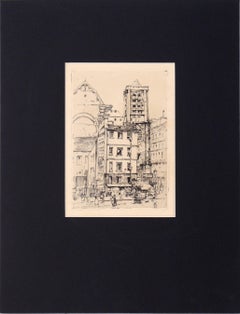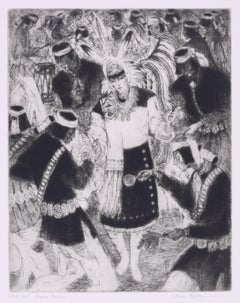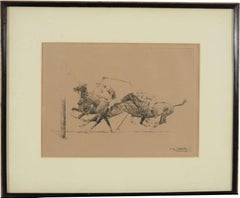Art by Medium: Drypoint
1910s American Impressionist Art by Medium: Drypoint
Paper, Ink, Drypoint
1990s Post-Modern Art by Medium: Drypoint
Drypoint, Aquatint
1960s American Realist Art by Medium: Drypoint
Drypoint
20th Century Art by Medium: Drypoint
Drypoint
20th Century Art by Medium: Drypoint
Drypoint
Mid-20th Century Modern Art by Medium: Drypoint
Paper, Drypoint, Etching
Mid-20th Century Modern Art by Medium: Drypoint
Paper, Drypoint, Etching
1870s Old Masters Art by Medium: Drypoint
Intaglio, Etching, Drypoint, Laid Paper
20th Century Art by Medium: Drypoint
Drypoint
20th Century American Modern Art by Medium: Drypoint
Drypoint, Etching
Mid-20th Century Modern Art by Medium: Drypoint
Paper, Drypoint, Etching
21st Century and Contemporary Contemporary Art by Medium: Drypoint
Drypoint
Mid-20th Century Modern Art by Medium: Drypoint
Paper, Drypoint, Etching
1970s Surrealist Art by Medium: Drypoint
Drypoint
Mid-20th Century Modern Art by Medium: Drypoint
Paper, Drypoint, Etching
1980s Academic Art by Medium: Drypoint
Drypoint
Mid-20th Century American Realist Art by Medium: Drypoint
Drypoint, Etching
1970s Modern Art by Medium: Drypoint
Paper, Ink, Drypoint
1980s Pop Art Art by Medium: Drypoint
Drypoint
Early 20th Century Victorian Art by Medium: Drypoint
Paper, Watercolor, Drypoint, Etching
Early 20th Century French School Art by Medium: Drypoint
Handmade Paper, Drypoint, Etching
1920s Art by Medium: Drypoint
Etching, Drypoint
1980s Modern Art by Medium: Drypoint
Drypoint
1970s Modern Art by Medium: Drypoint
Paper, Ink, Drypoint
21st Century and Contemporary Contemporary Art by Medium: Drypoint
Drypoint
1970s American Modern Art by Medium: Drypoint
Drypoint
1980s American Modern Art by Medium: Drypoint
Drypoint, Etching
Early 20th Century American Modern Art by Medium: Drypoint
Handmade Paper, Drypoint, Etching
21st Century and Contemporary Contemporary Art by Medium: Drypoint
Drypoint
1920s Art by Medium: Drypoint
Drypoint, Etching
1910s Modern Art by Medium: Drypoint
Drypoint, Etching
1940s Surrealist Art by Medium: Drypoint
Drypoint, Etching
20th Century American Modern Art by Medium: Drypoint
Drypoint, Etching
1910s Modern Art by Medium: Drypoint
Etching, Drypoint
Early 20th Century Romantic Art by Medium: Drypoint
Paper, Ink, Drypoint
1910s Modern Art by Medium: Drypoint
Etching, Drypoint
1910s Modern Art by Medium: Drypoint
Etching, Drypoint
Early 1900s Art Nouveau Art by Medium: Drypoint
Drypoint
1940s American Realist Art by Medium: Drypoint
Drypoint
1920s Other Art Style Art by Medium: Drypoint
Drypoint, Etching
1940s American Realist Art by Medium: Drypoint
Drypoint
21st Century and Contemporary Contemporary Art by Medium: Drypoint
Drypoint, Etching, Paper
Early 20th Century Naturalistic Art by Medium: Drypoint
Paper, Ink, Drypoint
1930s Modern Art by Medium: Drypoint
Drypoint
Early 1900s Art by Medium: Drypoint
Etching, Drypoint
1980s Contemporary Art by Medium: Drypoint
Drypoint
1920s American Modern Art by Medium: Drypoint
Drypoint
Mid-20th Century American Modern Art by Medium: Drypoint
Drypoint, Etching
1920s Modern Art by Medium: Drypoint
Drypoint, Etching
1870s Impressionist Art by Medium: Drypoint
Drypoint
1940s Surrealist Art by Medium: Drypoint
Drypoint
1980s Minimalist Art by Medium: Drypoint
Paper, Ink, Drypoint
1920s Art by Medium: Drypoint
Drypoint
1970s Surrealist Art by Medium: Drypoint
Drypoint, Aquatint
1990s Pop Art Art by Medium: Drypoint
Etching, Drypoint
1990s Pop Art Art by Medium: Drypoint
Drypoint, Etching
Early 2000s Contemporary Art by Medium: Drypoint
Drypoint
Late 19th Century Impressionist Art by Medium: Drypoint
Etching, Drypoint





